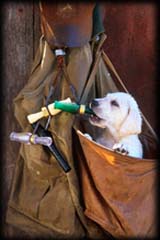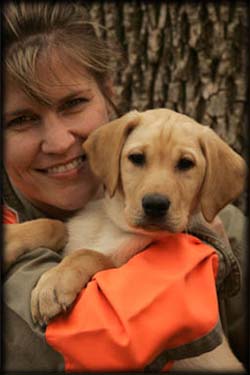-
 When picking out a quality
pup, get help from a reputable breeder and/or a professional trainer.
When picking out a quality
pup, get help from a reputable breeder and/or a professional trainer.
-
Fax information on pedigrees,
titles, etc. to a professional for their opinion and advice. Good
bloodlines generally tend to produce dogs with well established natural
instincts that are easier to work with.
-
When choosing a puppy from the
litter, try to pick a pup that is well balanced. Do not pick the shy
puppy or the pup that is overly aggressive.
-
Spend as much time as possible
socializing with your puppy, especially in the first 3 months.
-
Take the puppy to lots of
different places, both on foot and in your vehicle.
-
Get the puppy used to climbing
over obstacles, like your legs, logs, stairs, creekbeds, etc.
-
Spend time walking with and
playing with your puppy in shallow water before attempting to encourage
swimming.
-
Make sure your puppy is
swimming confidently before letting him on the dock or boat, then
gradually get him used to riding in the boat.
-
Start teaching your puppy to
use his eyes and nose by throwing pieces of dog food on the floor a short
distance for a few throws. Repeat the throw when the pup is not
looking. When the pup looks, point the direction of the throw as if
you just threw the food. This works well for starting some simple
casting. Let them chase the food off the sidewalk into the grass.
This will encourage them to use their nose to hunt for it.
-
Start some VERY LIGHT
obedience training, consisting of sit, heel, kennel, and recall with using
the "here" command. You can use a little dog food as treats to
encourage a good attitude. Keep these early sessions short so that
your puppy associates training as a fun activity.
-
DO NOT teach your puppy to lay
down until most of the training is finished. This will help prevent
your pup from laying down and quitting when learning new commands.
-
Limit your pup's exposure to
other dogs until at least 5 months of age. This will help prevent
him from bonding with another dogs instead of people. That could
cause him to look for a way out when basic obedience training starts, and
make him want to play with other dogs instead of focusing on pleasing you.
-
After 5 months of age and
basic obedience training has been started, let the puppy play with other
dogs occasionally so that he learns to socialize with other dogs as well.
-
Only throw 2 or 3 retrieves,
then put the object away. Start with tennis balls, and eventually
change to canvas dummies, then rubber dummies. As the puppy gets
older, mix in some larger dummies.
-
As your puppy gets good at
retrieving, start to challenge him by throwing objects into light cover
and/or out in the dark. This will encourage him to learn to use his
nose.
-
Put a collar on, and attach a
short 18" length rope to it. Let them step on the rope for a few
days. Then, put a leash on and condition the puppy to walking on a
leash.
-
It is HIGHLY recommended that
your puppy be a house dog. House dogs are better socialized and bond
to people much better, and also tend to be more easily trainable.
Note: 3/4 of all National Field Champion retrievers grew up as house dogs.
-
We recommend starting puppies
on dead pigeons first, then clipped wing pigeons around 4 months of age.
Limit the access to the bird, or your puppy may not want anything but
birds to retrieve.
-
We highly recommend the
purchase of the following video: Jackie Mertens Sound Beginnings
Retriever Training DVD, available below:





